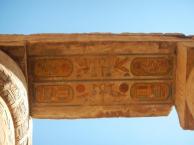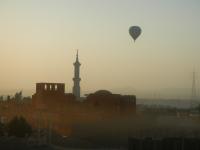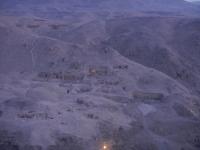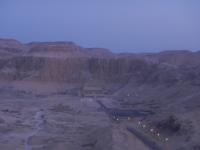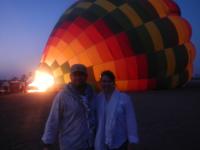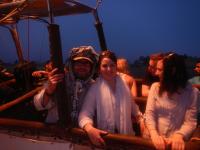Profile
Blog
Photos
Videos
Day 37, 10 August 2012, Sunrise Balloon Ride over Valley of the Kings, Visit to The Colossi of Memnon and three of the Valley of the Kings tombs, Visit to the Mortuary Temple of Hatshepsut - Egypt's female king, Alabaster factory visit and last, but not least, Karnak Complex and the sleeper train back to Cairo -
There are many "must-do" balloon rides in the world - so far we've ballooned in Queenstown, the Serengeti and have plans for Cappadocia in Turkey. Today's balloon ride was a temptation we had resisted - right up until the trip to Abu Simbel couldn't get enough participants and became a bus trip instead of a flight. And so the refund went on today's balloon ride. The economies of a year's worth of travel indeed! We left the hotel super early and headed to the departure point on the West Bank of the Nile. We had heard that it wasn't one of the world's best balloon rides - given that much of the Valley of the Kings is underground, but we were still excited. The ride cost a fraction of the Serengeti experience and it was unfortuneately clear why. Even to our novice eyes it was obvious there were serious shortcomings in the training and safety procedures - instead of filling the balloons on the ground with cold air then using fire at the very end to right them and take off, these cowboys were doing hot air inflations and had the punters in the basket far too soon. We also learned that ballooning is very, very hard. That our wonderful pilot was doing an excellent job and he was not able to predict the direction or strength of the wind. And that we were incredibly fortunate to have even achieved elevation at all - let alone to have had brief glimpses of Ramses II's tomb and the mortuary temple of Hatshepsut. Obviously we also learned that whilst most Egyptian men are wonderful, it was a wonder our pilot's ego could fit in the balloon basket - he did not take questions at all well! We did see a beautiful sunrise and our glimpse of Hatshepsut's temple was great, we even saw the building where the Carter expedition based itself, but it truly was not the most stunning of balloon rides. A minibus took us back to rendezvous with the rest of our group on the coach and we then visited the Colossi of Memnon, still in the relative cool of the day. It probably should go without saying - but these twin statues were colossal! They depict Amenhotep III (1400 BC approx) and stand in the Theban necropolis - across the Nile from modern day Luxor. They would have stood at the entrance to his mortuary temple - due to earthquakes and repeated flooding over the centuries there is nothing left but the statues. Standing 18 m tall and weighing 720 tonnes each, they were originally built from enormous stone blocks quarried near Cairo and then transported overland to Thebes. They were much too heavy to make the journey south on the Nile. They were seriously damaged in an earthquake in 27 BC and were later rebuilt by Alexander the Great. You might well wonder why a temple to Amenhotep III is now referred to as the Colossi of Memnon. It seems that the earthquake caused a crack in one of the statues and this possibly led to a sound seeming to come from the statue itself. The sound was often heard at dawn and Memnon means "Ruler of the Dawn". Hearing the sound was thought to bring good luck - others believed it was the sound of the goddess mother mourning her lost children. Wind through a crack? Expansion of stone with morning heat? We definitely didn't hear it during our visit. Further research seems to suggest it was last heard in 196 A.D... lucky we didn't hang about waiting). We continued on to the Valley of the Kings by which time it was a very warm day - mid thirties and not even lunchtime. Our tickets allowed us entry to three tombs and even with the postcard touts and tourists everywhere, it was an entrancing experience - the colours and details of the hieroglyphs were superb - no photographs were allowed which meant concentrating on the amazing paintings. The most well known of the Valley of the Kings tombs is that of Tutankhamun - the treasures were discovered by Carter in the 1920s and we were lucky to see them in the Egyptian Museum. We visited one tomb that was up a slope and a bit more difficult to get to - worth it though for the cool tranquility it afforded. It does not pay however to go too far away from the relative safety of the crowds - suddenly no one else was around and one of the ubiquitous scarf sellers was trying to sell me a scarf whilst simultaneously copping a feel of my chest! Patently he was not a god-fearing soul during the holy time of Ramadan and James and I gave him a massive and very loud telling off and he scurried away apologising profusely - fearful of the tourist police giving him hell we expect. Back into the little tram (ahhhh - the rest, the shade) we returned to the coach and onwards to Hatshepsut's mortuary temple at Deir el Bahari ("Hat-cheap-suit" for foreigners with retention difficulties - also Hot-chicken-soup - but that's just getting silly). It was deja-vu all over again for us - having seen the temple from the air only a few hours before. Massive and stunning were the words that came to mind. The temple is in incredible condition because it has been almost entirely reconstructed. It would be a shame to do this to everything, but stunning to see what it was like when it was built. It was the first grand complex to be built on the site later known as the Valley of the Kings. To be associated with its grandeur was why the area was chosen by later pharaohs for their tombs. The main building is called Djeser-Djeseru - the sublime of sublimes. Hatshepsut ("Foremost of Noble Ladies") wasn't the first or only female King of Egypt (they actually had no concept of Queen), but she is the most well known of the female Pharaohs. Hatshepsut's reign of 22 years was considered generally peaceful and she created many overseas trading relationships before she died in 1458 BC. (The other notable female king was Cleopatra VII, the last Pharaoh of ancient Egypt - it seems only days ago we were diving on antiquities from her time in Alexandria harbour!) Hatshepsut's mortuary temple is seen as a huge contribution to the architecture of the time - full of classical symmetry and colonnaded glory - almost 1000 years before the Parthenon was built. Whilst a fascinating visit it was still eerie to think that this was the site of the massacre of 62 tourists in only 1997. Attributed to an Islamic group, six gunmen disguised as security personnel murdered visitors to the site and later killed themselves. Not surprisingly this had a shocking impact on Egypt's tourism industry which had barely started to recover when September 11, 2001 arrived and the twin towers were destroyed. Dwelling on the past is obviously the purpose of a trip to Egypt, but still - time to move on. A tour of Egypt would not be complete without a visit to an alabaster factory (at least that's what our guide told us!) The hills of the Valley of the Kings consist of this stunning material and apparently if we asked nicely at the store then the owner would give us icecreams. And he did! One sure way of keeping hot, tired tourists happy during an alabaster polishing demonstration! It was fascinating and there were many beautiful things - but aside from its colour and polish and the craftsmanship of many of the handmade items, alabaster should primarily be known for being heavy. Fine if you're going home after Egypt - not so fine with another 10 months of travel ahead. By this point in the day we were all keen to get back to the hotel and freshen up prior to the overnight train back to Cairo - but we were reminded we were actually off to Karnak, the largest ancient religious site in the world. The Karnak complex is north of Luxor and the end point of the 2.7 km Avenue of the Sphinxes that we saw the other night. The site of many, many temples, Karnak is different to most other Egyptian monuments because of the length of time over which it was constructed and because approximately 30 pharaohs are believed to have contributed to the complex. It even has some Christian churches built amongst the ruins dating from around 356 AD. These were constructed after Constantius II declared all pagan temples should be closed (Karnak had fallen into disuse by then). The complex consists of 4 main areas of which only one is open to visitors - the precinct dedicated to Amun-re. The main feature of this area is the Hypostyle Hall - this alone covers 50,000 m2 and consists of 134 huge columns laid out in 16 rows (so don't think there isn't much to see!) We were grateful for the shade of the columns as our Egyptologist guide Momo wove stories of war, worship and intrigue. It was late afternoon, but the height of an Egyptian summer saw the handy labels wearing off the back of our camera and a heat haze blocking the lens. We soldiered on like a battle legion (albeit on its last legs) and were soon standing beside Karnak's sacred lake (and wondering what the fine for jumping in might be...) The lake was fed by groundwater and used for the water requirements of the complex - the water, once purified was used in rituals and it was also home to the sacred geese of Amun. Apparently many temples had a similar lake - not just for practical reasons, but as part of the concept of creation and the sacred waters from where all life arose. Near the lake stands the monumental scarab of Amenhotep III. We're not sure if it has any factual basis, but apparently if you circle the scarab 7 times then your most ardent wish will come true. So despite the temperature being in the high 40s, circling was accomplished. The final highlight of Karnak was seeing the tallest surviving ancient obelisk in the world. It is one of a pair erected by Hatshepsut at the entrance to the Temple of Mut (an ancient and great goddess of the earth, even then). The pair were the tallest in the world at the time they were erected, part of Hatshepsut's restoration of the Mut precinct which had been destroyed by the Hyksos. Feeling in need of serious restoration ourselves, it was a long slow walk back through Karnak to our much loved and well air-conditioned coach. We had some time for a swim and change at the Sonesta before we headed to Luxor's stunning train station for the sleeper to Cairo (with massive columns and marble everywhere, even the station looked like an ancient monument). We were lucky to have bought a great tour at a good price - it made us feel secure given the recent revolution in Egypt and we certainly saw and learned more than we ever could have alone. However, when we reached the bustling area around Luxor's train station, we both thought we'd like to come back this way someday. A long but worthwhile day - the balloon ride at sunrise seemed like a lifetime ago.
Postscript - 26 February 2013: In the midst our European adventures we saw the headlines of the fatal hot air balloon crash in the Valley of the Kings. Nineteen perished in the tragedy. We agreed that if we ever again thought a tourist operation looked unsafe, we would not go ahead with it, no matter the cost to cancel.
- comments





